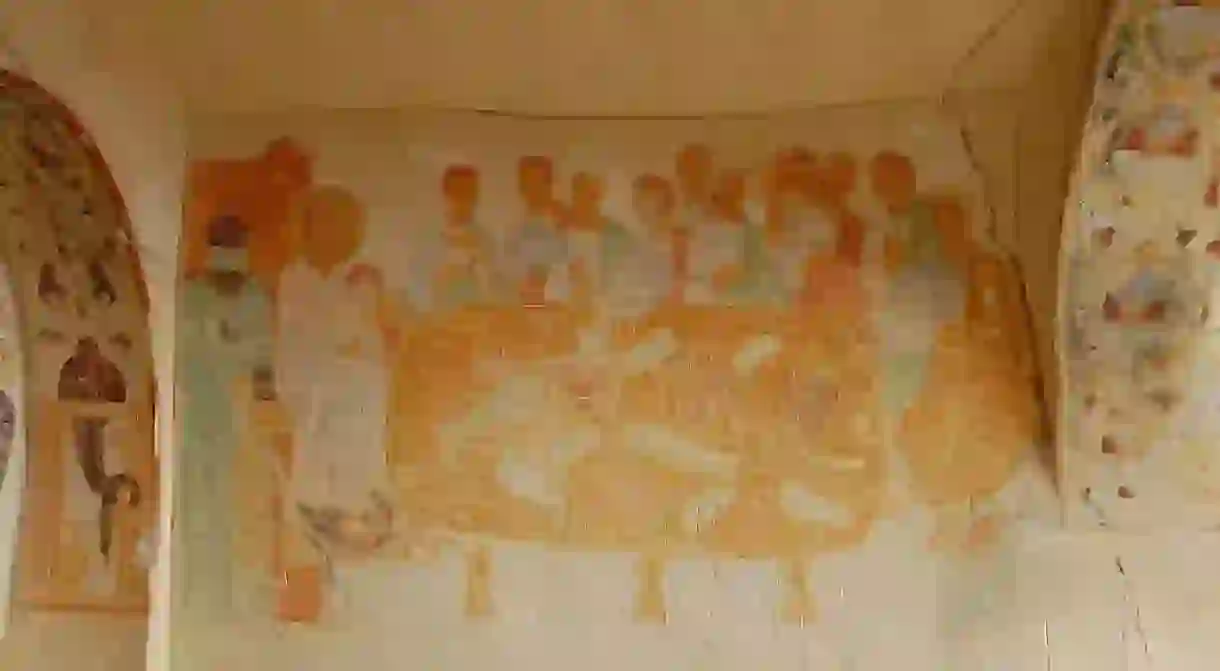Where to Admire Ancient Fresco Paintings in Georgia

Painting is the oldest art, as the first paintings were cave paintings, rubbed into the rock surface with fingers and elements from nature. Over the course of the centuries, different styles developed. One of the most significant and early painting styles in Georgia is the monumental fresco. Besides decorative function, frescoes had a cognitive connotation too. Images on the walls of the cathedrals depicted scenes from the Bible and served as an alternative visual form of educating the public about the men and women of scripture and the power of God. Almost every church across the country is adorned with frescoes, but we’ve made a list of the most ancient paintings you can visit and admire.
Dzalisa mosaic
The oldest fresco that has been discovered in Georgia dates back to the first quarter of the 3rd century. This is a mosaic found in the ancient city of Dzalisa, located 20 kms (12.4 miles) from Mtskheta. The mosaic adorned the floor of a bath house and its composition includes romantic mythological characters, an underwater world, animals, birds, vegetation, and even geometric ornaments.

Bichvinta mosaic
Another old sample of Christian art is the mosaic floor at Bichvinta church dating back to 5th-6th centuries. The decorative elements of the floor include animals, birds, fountains, and plants.

Tsilkani Monastery
One of the earliest examples of painted icons is at Tsilkani Monastery. It dates back to the 9th century. Depicting Virgin Mary, the icon also represents Archangels on both sides of her. Her almond-shaped eyes with pink spots on her cheeks and forehead draw the eye of the viewer.

Gelati Monastery
The main temple of Gelati monastery, named after the Virgin Mary, is another very important example of Georgian fresco paintings. A mosaic adorns the cone of the cathedral sanctuary that dates back to 1125-1130. Virgin Mary is holding baby Jesus, while images of Archangels Michael and Gabriel are depicted on her sides. Large and rich decorated figures are presented on a golden background.

David Gareji
The frescoes in the David Gareji monastery are impressive with their colorful, bluish-red and white figures standing against a bluish background. One of the interesting areas of the complex, the dining space for monks, has significant examples of frescoes too. Biblical scenes here are selected according to the space’s purpose. For instance, you’ll see The Last Supper scene in the dining hall, while columns showcase images of Davit Garejeli, Ekvtime Mtatsmindeli, and other monks.

Ateni Sioni
The frescoes presented at Ateni Sioni belong to the 10th-11th centuries. During this period, painters showcased larger images that led to a different representation of gospel stories.

Vardzia cave monastery
The frescoes of this church hidden within a cave are one of the most brilliant examples of medieval wall painting. Here, the figures are depicted differently from different angles. Since figures are different sizes on the uneven cave wall (depending which way you look at them), they easily draw and keep the attention of viewers. Moreover, the Biblical scenes are displayed in a zig-zagging way, as if each is trying to fill the free space on the wall.

Timotesubani Church
Timotesubani Church frescoes are among the most significant monuments of the 12th century. They were painted in the difficult style of iconography. The walls show episodes of the life of the Christ and the Virgin Mary, as well as the stories that take place in the Gospel. Here you can look upon the impressive fresco of the Last Judgment. The figures here are emotional, flexible and moving.

Kintsvisi Church
Here frescoes are on each wall of the church, which used to be a characteristic of previous epochs and not of the 13th century. Kintsvisi paintings are especially impressive with sophisticated forms and faces of the figures. Especially effective is the color palette, which includes light green, reddish-brown, pale blue, and other colors.














